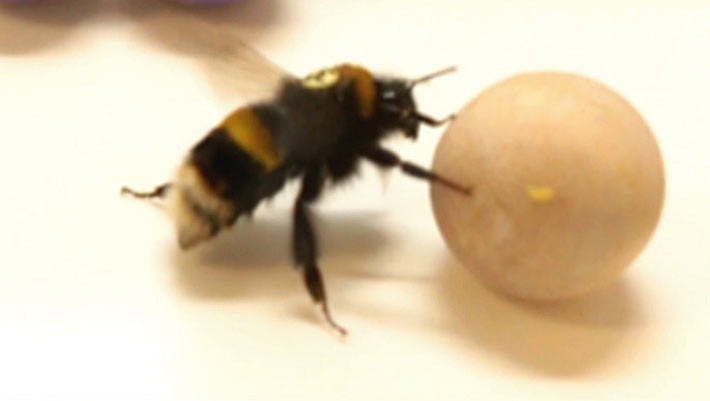New research led by Queen Mary University of London shows that rolling of wooden balls by buff-tailed bumblebees (Bombus terrestris) fulfils behavioral criteria for animal play and is akin to play in other animals.
Ball-rolling action by a buff-tailed bumblebee (Bombus terrestris). Image credit: Dona et al., doi: 10.1016/j.anbehav.2022.08.013.
Play is not limited to humans, but is a phenomenon seen across many animal species.
It is thought to contribute to the healthy development and maintenance of an animal’s cognitive and motor abilities, which may, for example, benefit foraging strategies, and is considered an important aspect of animal welfare.
Most clear examples of play come from large-brained mammals and birds, whereas systematic investigations of play in other animals are very limited. This may be because it has been historically difficult to define and investigate play behavior across different animals.
“Our research provides a strong indication that insect minds are far more sophisticated than we might imagine,” said senior author Professor Lars Chittka, a researcher at Queen Mary University of London.
“There are lots of animals who play just for the purposes of enjoyment, but most examples come from young mammals and birds.”
“We are producing ever-increasing amounts of evidence backing up the need to do all we can to protect insects that are a million miles from the mindless, unfeeling creatures they are traditionally believed to be.”
In the study, Professor Chittka and colleagues followed 45 buff-tailed bumblebees in an arena and gave them the options of walking through an unobstructed path to reach a feeding area or deviating from this path into the areas with wooden balls.
Individual bees rolled balls between 1 and, impressively, 117 times over the experiment.
The repeated behavior suggested that ball-rolling was rewarding.
This was supported by a further experiment where another 42 bees were given access to two colored chambers, one always containing movable balls and one without any objects.
When tested and given a choice between the two chambers, neither containing balls, the bees showed a preference for the color of the chamber previously associated with the wooden balls.
The set-up of the experiments removed any notion that the bees were moving the balls for any greater purpose other than play.
Rolling balls did not contribute to survival strategies, such as gaining food, clearing clutter, or mating and was done under stress-free conditions.
“It is certainly mind-blowing, at times amusing, to watch bumble bees show something like play. They approach and manipulate these ‘toys’ again and again,” said Samadi Galpayage, a Ph.D. student at Queen Mary University of London.
“It goes to show, once more, that despite their little size and tiny brains, they are more than small robotic beings.”
“They may actually experience some kind of positive emotional states, even if rudimentary, like other larger fluffy, or not so fluffy, animals do.”
“This sort of finding has implications to our understanding of sentience and welfare of insects and will, hopefully, encourage us to respect and protect life on Earth ever more.”
The findings were published October 19, 2022 in the journal Animal Behaviour.
_____
Hiruni Samadi Galpayage Dona et al. Do bumble bees play? Animal Behaviour, published online October 19, 2022; doi: 10.1016/j.anbehav.2022.08.013


